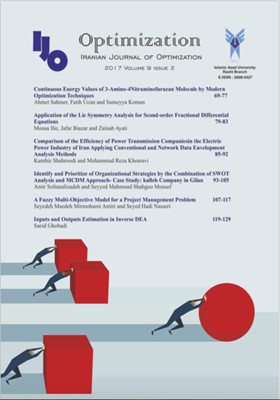Comparison of the Efficiency of Power Transmission Companies in the Electric Power Industry of Iran Applying Conventional and Network Data Envelopment Analysis Methods
الموضوعات : Data Envelopment AnalysisKambiz Shahroodi 1 , Mohammad Reza Khosravi 2
1 - Associate Professor of Business Administration Administration, Islamic Azad University of Rasht, Iran
2 - PhD student of Business Administration, Islamic Azad University of Rasht, Iran
الکلمات المفتاحية: Efficiency, Performance Evaluation, Network data envelopment analysis, Regional Electricity Company, Iran', s Electricity Industry,
ملخص المقالة :
This study is an applied study conducted to evaluate and compare the efficiency of Iran's regional power companies using conventional and network Data Envelopment Analysis methods. Iran's regional power companies use two- phased process to transmit power. Using applied approach, the performance and efficiency of these companies were measured with network and conventional methods, and they were compared with each other (input-oriented BCC). It was indicated that network models have wider application compared with other method since it provides vivid picture of the efficiency of regional power companies. The Wilcoxon test result shows there is significant difference between efficiency scores of Iran's regional power companies using BCC and network methods, and investigation of the quality of difference of scores also indicate that efficiency of companies in the network model is lower than efficiency scores of BCC model. In general, network models have higher application than to provide a vivid picture of the efficiency of regional electricity companies and more accurate comparison of them.
Ahmadi Movaghar, S. (2008). Performance Evaluation and Optimization of Transmission Sector in Regional Electricity Company Through Combination of Multiple and Intelligence Analysis Techniques (Data Envelopment Analysis and Genetic Algorithm); MA thesis; Technical Faculty of Tehran University (in persian)
Banker. R,D. Charnes, A., & Cooper,W,W. (1984). Some Models for Estimating Technical and Scale Efficiencies in Data Envelopment Analysis. Management Science, 30: 1078-92.
Castelli, L., Pesenti, R. & Ukovich, W. (2004). DEA-like models for the efficiency evaluation of hierarchically structured units. European Journal of Operational Research, 154: 465–76.
Charnes, A., Cooper, W. W., & Rhodes, E. (1978). Measuring the efficiency of decision- making units. European Journal of Operational Research, 2: 429–44.
Chen, C. & Yan, H. (2011). Network DEA model for supply chain performance evaluation. European Journal of Operational Research, 213: 147–55.
Cook, W.D., Zhu, J., Bi, G. & Yang, F. (2010). Network DEA: additive efficiency decomposition. European Journal of Operational Research, 207: 1122–9.
Emami Meybodi, A., Afghah, M., & Rahmani Sefati, M. H. (2009). Measuring the Technical Efficiency and Productivity in Steam, Gas and Combined Sycle Power Stations. The Quarterly of Quantitative Economy, (3) 6, 79-103.
Fare, R., & Grosskopf, S. (2000). Network DEA. socio-economic plannig science, 34: 35-49.
Farell, M. (1957). The measurement of productive efficiency. Journal of the Royal Statistics Society, Series A, 120 (3): 253-281.
Fukuyama, H. & Weber, W.L. (2010). A slacks-based inefficiency measure for a two-stage system with bad outputs. Omega, 38: 398–409.
Iran Monneko Consulting Engineers Company. (2013). Restructuring in Power Industry. Tehran: Shiveh Publications.
Kao, C. & Hwang, S.N. (2008). Efficiency de composition in two-stage data envelopment analysis: an application to non-life insurance companies in Taiwan. European Journal of Operational Research, 185: 418–29.
Kao, C. (2009). Efficiency decomposition in network data envelopment analysis: A relational model. European Journal of Operational Research, 192: 949–62.
Khosravi, M.R. & Shahroudi, K. (2014). Applying Network Data Envelopment Analysis Model to Measure Efficiency of Iran Electric Power Transmission Industry Sector. Industrial Management, 6 (2), 263- 282. (in persian)
Kwon, H.B., MarveJ, H.& Roh, J.J. (2016). Three-stage performance modeling using DEA-BPNN for better practice benchmarking, Expert Systems with Applications, 71 (1). pp. 429–441.
Li, Y., Chen, Y., Liang, L. & Xie, J. (2012). DEA models for extended two-stage network structures. Omega, 40: 611–18.
Liang, L., Yang, F., Cook, W.D. & Zhu, J. (2006). DEA models for supply chain efficiency evaluation. Annals of Operations Research, 145: 35–49.
Ma, J., Qi, L. & Deng, L.(2017). Efficiency measurement and decomposition in hybrid two-stage DEA with additional inputs, Expert Systems with Applications, 79 (15). pp.348–357.
Mehregan, M. R. (2004). Quantitative Models for Performance Evaluations of Organizations. Teharn: Teharn University Management College Publications.
Mo'meni. M. & Shahkhah, N. (2011). The Use of Communication Two-Phase Data Envelopment Analysis Model in Efficiency Evaluation. Daneshvar Raftar, (47-1), 333-344.
Salehzadeh, S. J., Hejazi, S. R., Arkan, A. V., & Hoseini, S. M. (2011). Presenting a Synthetic Method of Efficiency Measurement of Network Structures Including Allocated Revolution and Links. Journal of Production and Operation, (1), 47-60.
Shahriari, S., Razavi, S. M., & Asgharizadeh, A. (2013). Fuzzy Data Envelopment Analysis and the New Approach FIEP/AHP to Complete Ranking of Decision Making Units. (Case Study: School of Humanities of Tehran University). Industrial Management, 5 (1), 21-42.
Tone K. & Tsutsui M. (2009). Network DEA: a slacks-based measure approach. European Journal of Operational Research, 197: 243–52.
Wang, Q. Hang, Y., Sun, L. & Zhao, Z. (2016). Two-stage innovation efficiency of new energy enterprises in China: A non-radial DEA approach, Technological Forecasting & Social Change, 112 (1). pp.254–261.


